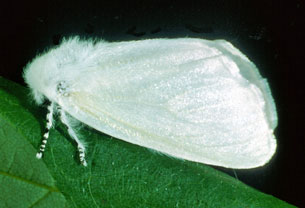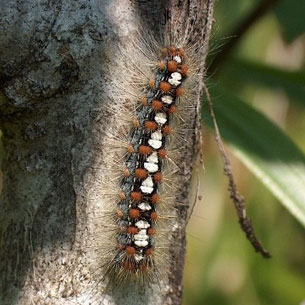Satin Moth
The Satin Moth (Leucoma salicis) is a non-native insect that was introduced to North America from Europe in the early 1920s. The caterpillar feeds primarily on the leaves of poplar species. They have also been known to feed on willow and oak trees.
Satin Moths can completely strip and defoliate large mature trees of all their leaves. They produce two occurrences of leaf eating caterpillars in a season and therefore can defoliate a tree twice. Mature healthy trees normally have enough resources stored to be able to recover from this type of damage. Repeated, severe defoliation over a few seasons can result in tree mortality. Rolled leaves containing pupae and silk webbing on stems and branches are signs of the Satin Moth pupae.

Satin Moth
Identifying the Satin Moth
The mature Satin Moth caterpillars grow to be 3.5 to 4.5 cm long, and are pale to medium grey-brown, with a darker head and back. Their backs are black with a central row of white or light yellow markings. They can be confused with the tent caterpillar which has a white strip down its back bordered by two blue lines. The adult moths have pure white wings with a satin-like lustre. They have a wingspan ranging from 3.5 to 5.0 cm and can be distinguished from other local white species by narrow alternating black and white bands on their legs.

Satin Moth caterpillar
Satin Moth control
Several parasitoids and predators exert significant mortality on Satin Moth. At least three parasitoids are established on satin moth in Calgary. These species are now established on satin Moth in Calgary and, as such, additional control measures are considered unnecessary at present.
Some cultural practices can be used by homeowners to control satin moth. In the spring, a sticky band can be placed around the trunk at breast height to capture emerging larvae. Newly hatched larvae can be power washed off tree trunks. Egg masses can also be scrapped off trees when found.

